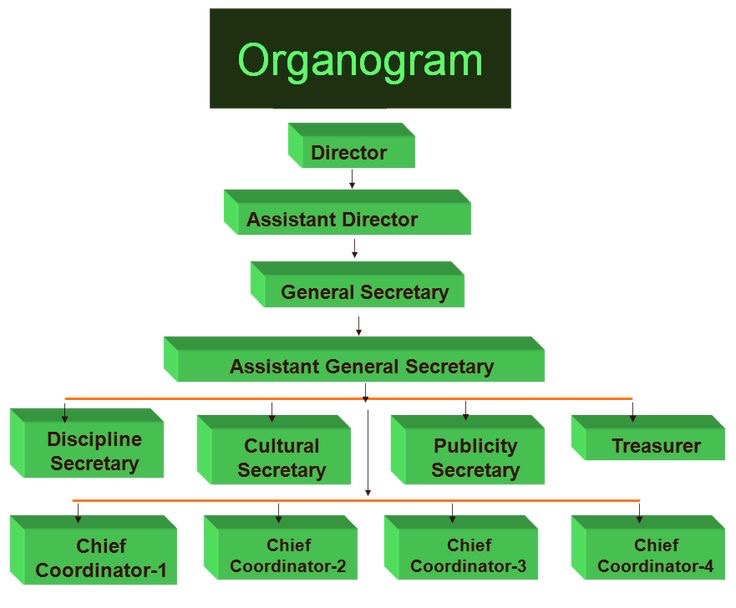An organogram is an indispensable tool in the hands of visionary leaders committed to building resilient and thriving enterprises. It is a dynamic roadmap for organizational success.
Creating an organogram or organizational chart for your company is like mapping out the DNA of your organization. This visual representation serves as a compass, guiding everyone through the intricate web of roles, responsibilities, and relationships within your company.
In this guide, we’ll unravel the art and science behind crafting an effective organogram – covering the types, key considerations, and importance of creating a company organogram.
Table of Contents
Things to Put in Place When Creating an Organogram
An organogram is a diagram that shows the structure of an oragnization and the relationships between the different people, departments, and jobs at different levels within the organization. The following things should be put in place when creating an organogram;
-
Hierarchy harmony
- Establish a clear hierarchy that reflects the chain of command within your organization.
- Consider the flow of authority and decision-making, ensuring that reporting lines are logical and streamlined.
-
Role definition and clarity
- Clearly define the roles and responsibilities associated with each position on the organogram.
- Avoid ambiguity by providing concise and easily understandable job descriptions for each role.
Read also: Types of Jobs in Nigeria: A Breakdown for Better Career Decisions.
-
Departmental dynamics
- Identify key departments and their interdependencies.
- Ensure that the organogram accurately represents the relationships between different departments, fostering a holistic understanding of the organization’s structure.
-
Company culture integration
- Tailor the organogram to align with your company’s unique culture.
- Consider cultural aspects such as collaboration, innovation, or tradition when designing the chart to reflect the ethos of your organization.
-
Flexibility for growth
- Design the organogram with adaptability in mind.
- Create a structure that can accommodate growth and changes within the company, avoiding the need for frequent overhauls.
-
Effective communication channels
- Ensure that your organogram facilitates efficient communication channels.
- Highlight the lines of communication within and between departments, promoting a culture of open and transparent communication.
-
Technology integration
- Explore the use of organogram software to streamline the creation and maintenance of the chart.
- Leverage technology for easy updates, allowing the organogram to evolve alongside your dynamic organization.
Types of Organograms
-
The traditional pyramid

Traditional pyramid organogram
This classic example illustrates a top-down hierarchy with clear reporting lines. It’s a straightforward representation commonly seen in more traditional organizational structures. Each level signifies a different tier of management, providing a simple yet effective overview of the organization’s leadership.
-
The flat structure
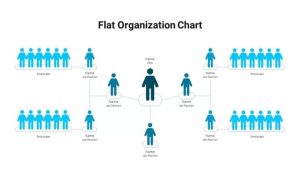
Flat structure organogram
In contrast to pyramid organogram, this example showcases a flat organizational structure. With fewer management layers, this type of organogram promotes a more decentralized decision-making process. It’s ideal for fostering a collaborative and agile work environment, emphasizing open communication and a sense of equality among team members.
-
Matrix organogram
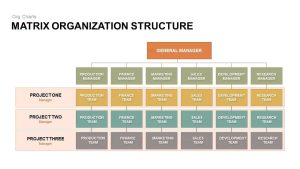
Matrix organogram
For organizations with cross-functional teams and diverse projects, the matrix organogram is a go-to choice. This example demonstrates how individuals report to multiple supervisors based on project assignments. It highlights the flexibility and adaptability required in dynamic work environments.
-
Hierarchical organogram
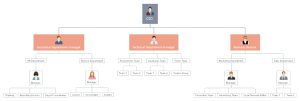
Hierarchical organogram
In an organization, think of a hierarchical organogram like a family tree for a company. It’s a visual map that shows who’s in charge and how information flows from the big bosses to the everyday workers. At the top are the top dogs, like the CEO, and as you go down, you find managers, team leaders, and regular employees.
It’s like a roadmap that helps everyone know their place and who to talk to. This structured picture makes sure things run smoothly by showing who reports to whom, making it easier for everyone to understand how the organization works.
Read also: How to Create a Compelling Company Profile for Your Business (Template).
How to Craft an Effective Company Organogram
Crafting an effective company organogram is akin to designing the blueprint for a well-functioning and harmonious workplace. This visual representation of the organizational structure is more than just lines and boxes; it’s a strategic tool that shapes the dynamics of your Nigerian company.
A well-thought-out organogram clarifies roles, fosters communication, and ensures that everyone is aligned with the overarching goals. Let’s delve into the key steps in crafting an organogram that not only captures the essence of your organization but also propels it toward success.
-
Define your goals
Clearly outline the objectives you want the organogram to achieve, whether it’s improving communication, streamlining decision-making, or optimizing resource allocation.
-
Understand your company’s structure
Analyze the existing hierarchy, departments, and teams to understand how different parts of the organization interact. This forms the basis for crafting a reflective organogram.
-
Identify key roles and responsibilities
Clearly define the roles and responsibilities of each position. This ensures that everyone knows what is expected of them and minimizes confusion.
-
Consider future growth
Anticipate future organizational changes and growth. Craft the organogram to be flexible enough to accommodate expansion or restructuring without a complete overhaul.
-
Promote inclusivity
Ensure that the organogram reflects the diversity within your organization. This promotes inclusivity and helps employees see themselves represented in the visual hierarchy.
-
Solicit feedback
Involve key stakeholders and employees in the process. Collect feedback to address concerns, ensure accuracy, and make adjustments that resonate with the actual work dynamics.
-
Use clear design elements
Keep the organogram visually clear and simple. Use easily understandable symbols, colors, and lines to convey information without causing confusion.
Read also: The Basic Elements of Design to Create Catchy Content Even if You’re not a Designer.
-
Regular updates
Recognize that your company is dynamic, and so should your organogram. Regularly update it to reflect changes in roles, responsibilities, or organizational structure.
Join our fast-growing WhatsApp community of young and talented individuals in different fields.
Importance of Creating an Effective Organogram
In this modern era of dynamic business environments, the importance of a well-thought-out organogram cannot be overstated. They include;
-
Clarity of hierarchy
An effective organogram provides a clear and concise depiction of the hierarchical structure within an organization. It outlines reporting relationships, making it easier for employees to understand their roles and responsibilities. This clarity helps in reducing confusion and fosters a sense of order within the workforce.
-
Efficient communication
By illustrating the lines of communication and authority, an organogram facilitates effective communication channels. This clarity streamlines decision-making processes, as employees know whom to approach for various matters. This, in turn, promotes a more efficient and responsive organizational culture.
-
Resource allocation
Crafting an organogram involves a careful consideration of resource distribution. It helps in identifying where resources, both human and material, are concentrated. This enables organizations to optimize resource allocation, ensuring that each department or team has the necessary support to fulfill its role effectively.
-
Team collaboration
An organogram not only defines individual roles but also highlights team structures and interdepartmental relationships. This visual representation fosters a greater understanding of how different teams collaborate to achieve common objectives. It encourages a sense of unity and cooperation among employees working towards shared goals.
-
Talent management
By mapping out reporting relationships and identifying key roles, an organogram aids in talent management. It allows organizations to recognize skills gaps and strategically plan for recruitment and employee development. This proactive approach ensures that the right people are in the right positions, contributing to the overall success of the organization.
-
Adaptability to change
In today’s fast-paced business environment, adaptability is crucial. An effective organogram is a dynamic tool that can be easily updated to reflect changes in organizational structure or strategy. This adaptability ensures that the organogram remains a relevant and useful resource as the organization evolves.
Challenges of Crafting an Organogram
Crafting an organogram, despite its apparent benefits, is not without its challenges. While this visual representation of an organization’s structure is meant to bring clarity, it can also pose several problems if not approached thoughtfully. Recognizing and addressing these issues is essential to ensure that the organogram serves its purpose without inadvertently causing more harm than good.
These issues could stem from things as little as oversimplification of roles, and rigidity in structure to complex problems like failing to reflect real dynamics, lack of representation to inadequate communications.
Conclusion
Creating a company organogram is a strategic undertaking that goes beyond lines and boxes. It’s a visual narrative of your organization’s structure, guiding employees, stakeholders, and even future recruits through the intricacies of your Nigerian business.
By putting to use all we have discussed in this guide and drawing inspiration from diverse organogram examples, you’ll be well-equipped to design a chart that not only reflects your organization’s current state but also paves the way for future success and growth.
Subscribe to our newsletter for more articles on Career, Enterprise, Lifestyle, Technology, and many more.
Edited by Oluwanifemi Akintomide.
About Author
- An SEO Content writer with dedicated 4 years experience. I have expertise in typically researching for topics, creating style guides for a company's content, and writing content that helps drive conversions based on the organization's goals.
Latest entries

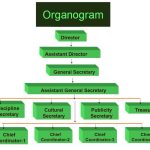 CareerFebruary 1, 2024Creating a Company Organogram/Organizational Chart: All You Need to Know
CareerFebruary 1, 2024Creating a Company Organogram/Organizational Chart: All You Need to Know CampusNovember 19, 2023Tuition-Free Universities in Germany: Relocating to Germany Through Study Route
CampusNovember 19, 2023Tuition-Free Universities in Germany: Relocating to Germany Through Study Route Business InsightsSeptember 15, 2023Top 20 Easy-to-Sell Courses on Expertnaire
Business InsightsSeptember 15, 2023Top 20 Easy-to-Sell Courses on Expertnaire

